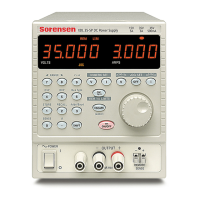24
Poll Configure command (PPC) followed by a Parallel Poll Enable command (PPE). The bits in
the PPE command are shown below:
bit 5 = 1 Parallel poll enable
sense of the response bit; 0 = low, 1 = high
bit 2 = ?
bit 1 = ? bit position of the response
Example. To return the RQS bit (bit 6 of the Status Byte Register) as a 1 when true and a 0 when false
in bit position 1 in response to a parallel poll operation send the following commands
*PRE 64
<pmt>, then PPC followed by 69H (PPE)
The parallel poll response from the instrument will then be 00H if RQS is 0 and 01H if RQS
is 1.
During parallel poll response the DIO interface lines are resistively terminated (passive
termination). This allows multiple devices to share the same response bit position in either wired-
AND or wired-OR configuration, see IEEE 488.1 for more information.
Status Reporting
A separate error and status model is maintained for each interface instance; an interface instance
is defined as a potential connection. USB, RS232 and GPIB are inherently single connections so
represent one interface instance each. LAN, however, allows for multiple simultaneous
connections and therefore represents multiple interface instances. Two interface instances are
allocated to the two TCP socket interfaces and one more is allocated to the Web page interface.
Having a separate model for each interface instance ensures that data does not get lost as many
commands e.g. ‘*ESR?’ clear the contents on read.
Error status is maintained using a set of registers; these are described in the following
paragraphs and shown on the Status Model at the end of this section.
Standard Event Status and Standard Event Status Enable Registers
These two registers are implemented as required by the IEEE Std. 488.2.
Any bits set in the Standard Event Status Register which correspond to bits set in the Standard
Event Status Enable Register will cause the ESB bit to be set in the Status Byte Register.
The Standard Event Status Register is read and cleared by the *ESR? command. The Standard
Event Status Enable register is set by the *ESE <nrf> command and read by the *ESE?
command.
It is a bit field where each bit has the following significance.
Bit 7: Power On. Set when power is first applied to the instrument.
Bit 6: User Request (Not used).
Bit 5: Command Error. Set when a syntax type error is detected in a command from the bus.
The parser is reset and parsing continues at the next byte in the input stream
Bit 4: Execution Error. Set when an error is encountered while attempting to execute a
completely parsed command. The appropriate error number will be reported in the
Execution Error Register, see Error Messages section

